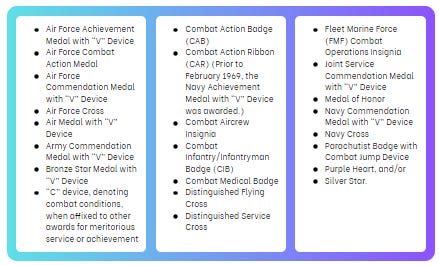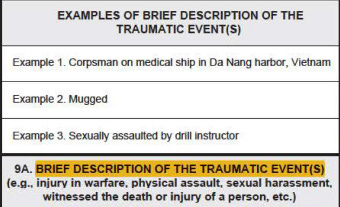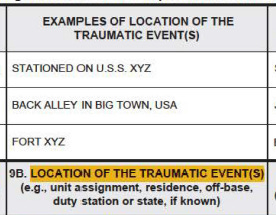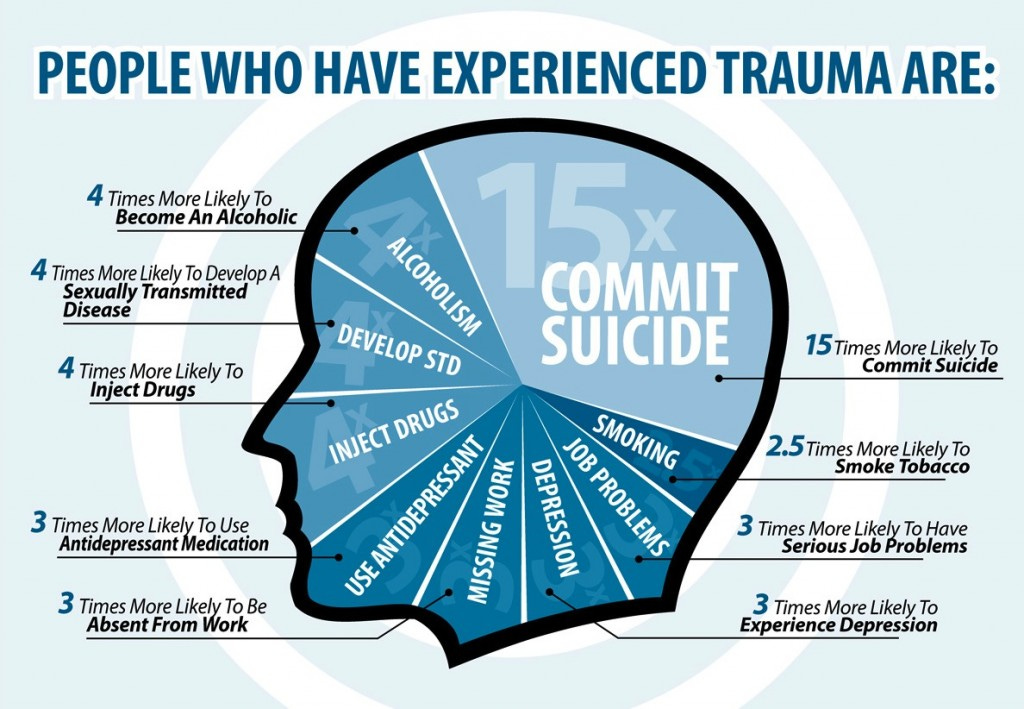This lunch and learn is broken up into three parts: (1) preparing a stressor statement, (2) reviewing the medical records and the importance of a diagnosis of PTSD, and (3) a separate statement regarding symptoms over time. This week, we will talk about how to prepare a stressor statement.
Step 1: Review the File
Check for Comp & Pen Exams already in the file:
What did they say?
What records did they review?
Do they note any markers in the file?
Review all prior statements about the PTSD stressor:
What information do you already have?
What information is missing?
Do any of the statements conflict with each other? (see Handling Contradictions section below)
Look for information about the stressor in Medical Records:
MHBSS Assessment - “Vet did not report direct combat exposure, but did note experiencing several ship fires during his service.”
Diagnosis of PTSD
Search for certain words that would indicate the veteran talked about the stressor (ie. “broom”, “assault”, etc.)
Identify Potential Markers in the Service Records:
Review all markers identified in previous Comp & Pen Exams
Review service records surrounding the date and/or location the veteran says the event took place to confirm details - ie. What rank was he at the time? Are there any service treatment records immediately before or after the assault occurred? When are there significant changes in his behavior (ie. he started drinking more, went AWOL, got into fights more, performance reviews became worse, etc.)
*IMPORTANT!! Document everything you found in the Claims Tab - Relevant Evidence Section in Neos so Amie doesn’t have to do it all over again later on down the road.
HANDLING CONTRADICTIONS
How your brain protects you from trauma. 1
Individuals with PTSD often struggle to recall specific details about traumatic events, such as the exact time and location, due to the way trauma impacts memory processing. The brain’s response to stress and trauma significantly affects how memories are encoded, stored, and retrieved. Here’s why this happens:
Disruption of Memory Encoding: During a traumatic event, the brain is flooded with stress hormones like adrenaline and cortisol. While these hormones prepare the body for a "fight-or-flight" response, they can impair the hippocampus, the part of the brain responsible for encoding and organizing memories. As a result, the brain may fail to store the event in a coherent, detailed manner (SpringerOpen)(Boston University).
Fragmented Memory Storage: Trauma can lead to the fragmented storage of memories. Instead of being encoded as a cohesive, linear narrative, the traumatic event is often stored as scattered sensory impressions, such as images, sounds, or emotions. This can make it difficult for individuals with PTSD to recall specific details like where or when the event happened because their memory of the trauma lacks structure and continuity (Oxford Academic).
Dissociative Responses: To cope with overwhelming stress, some individuals may experience dissociation during a traumatic event. Dissociation involves a psychological disconnection from the present moment, which can interfere with how the brain records the event. This results in gaps or missing details when the person tries to recall the experience later (JAAPL).
Impairment of the Prefrontal Cortex: The prefrontal cortex, responsible for higher-order thinking and decision-making, also plays a role in contextualizing and recalling memories. Under extreme stress, its function can be compromised, leading to difficulties in recalling the context of a trauma, such as its sequence, location, or timing (SpringerOpen).
What to Do When You Notice Inconsistencies in the Record:
Before you submit a new 21-0781 stressor statement, make sure you review any prior statements in the file that have already been submitted for consistencies or inconsistencies.
If you notice inconsistencies, review the Service Records and try to verify the details. Start with things such as:
location - military base, unit, etc.
date - try to locate any service treatment or personnel records dated around the time the stressor occurred to provide evidence of potential markers (performance evaluations, disciplinary actions, unit transfers, etc.)
Look for service records that indicate a change in behavior to narrow down the potential time frame the stressor may have occurred:
Did his performance evaluations get worse after a certain date?
Does he have a record of disciplinary actions after a certain date?
Was he transferred from one unit to another?
Did he visit sick call more frequently after a certain date?
Does he remember a significant event shortly before or after the stressor? (ie. birth of a child, divorce, etc.)
Use this information to put together a stressor statement that makes the most sense with the markers in the file.
*Be sure to explain any inconsistencies in prior statements by pointing out that memory loss is a common feature of PTSD and cite to the medical journal articles contained in Footnote 1, below.
Step 2: Draft a VA Form 21-0781
Try to put together as much information as you were able to gather from step 1, above, on the VA Form 21-0781 BEFORE you talk to the client about what happened in service. This way when you talk to the client, you are confirming certain details and filling in the gaps where necessary, instead of having them start from scratch and risk putting new information in there that contradicts any prior information already in the record.
SECTION II: TRAUMATIC EVENT INFORMATION
Combat - The ordinary meaning of the phrase “engaged in combat with the enemy,” as used in 38 U.S.C. § 1154(b), requires that a veteran have participated in events constituting an actual fight or encounter with a military foe or hostile unit or instrumentality.
When a veteran has received any of the combat decorations listed below, the VA will presume that the veteran engaged in combat with the enemy, unless there is clear and convincing evidence to the contrary:
*Receipt of one of the decorations cited above is not the only acceptable evidence of engagement in combat. The issue of whether any particular set of circumstances constitutes engagement in combat with the enemy for purposes of section 1154(b) must be resolved on a case-by-case basis.
Other Traumatic Events:
Examples of other traumatic events may include:
natural disasters
life-threatening disease of self or significant other
duty on burn ward
graves registration
witnessing the death, injury, or threat to the physical integrity of another person not caused by the enemy
actual or threatened death or serious injury, or other threat to one’s physical integrity not caused by the enemy
ship sinking, explosion, and/or plane crash during routine drills, or
friendly fire that occurs on a gunnery range during a training mission.
Fear of hostile military or terrorist activity means the veteran experienced, witnessed, or was confronted with an event or circumstance that involved (1) actual or threatened death or serious injury or a threat to the physical integrity of the veteran or others, and (2) the veteran’s response to the event or circumstances involved a psychological or psycho-physiological state of fear, helplessness, or horror.
Examples of exposure to hostile military or terrorist activity include:
actual or potential improvised explosive devices (IEDs)
vehicle-embedded explosive devices
incoming artillery, rocket, or mortar fire
small arms fire, including suspected sniper fire, or
attacks upon friendly aircraft.
IMPORTANT!! The main distinction between a combat and non-combat stressor is that the non-combat stressor must always be corroborated with credible supporting evidence. The Veteran’s lay statement, in the absence of any other credible evidence, cannot serve as evidence for verification of the stressor.
9A - Brief Description of the Traumatic Event
If you need more room use the Remarks section at the end of the 0781 form.
9B - Location of the Traumatic Event
IMPORTANT!!! Make sure to provide BOTH the location where the event took place AND the full unit designation. Most of the time, you can determine the unit designation by where/when the veteran says the event took place.
For Army requests, provide the full unit designation to the company level, such as:
HHC, 1st Brigade, 2d Armored Division (instead of 2d Armored Division only), and Company C, 1st Battalion, 14th Infantry, 1st Brigade Combat Team, 4th Infantry Division.
For Navy requests, provide the full unit designation and hull numbers for ships, such as: USS Franklin D. Roosevelt (CVA-42) instead of USS Roosevelt only.
For Air Force requests, at a minimum, provide squadron and group designations, such as: 366th Field Maintenance Squadron, 366th Combat Support Group instead of 366th Tactical Fighter Wing only. 2
9C - Dates of the Traumatic Event
Try to narrow down the approximate date within a two-month period of the event.
III. ADDITIONAL INFORMATION ASSOCIATED WITH THE IN-SERVICE TRAUMATIC EVENT
IF THE TRAUMATIC EVENT WAS COMBAT, YOU CAN SKIP THIS SECTION
Identifying “Markers” in the File
Ask the veteran about each of the following behavioral changes following the traumatic event and provide additional information (approximate time change occurred, documentation, or record):
INCREASED/DECREASED VISITS TO A HEALTHCARE PROFESSIONAL, COUNSELOR, OR TREATMENT FACILITY
veteran was seen for psychological counseling around the time of the reported rape
veteran requested and received testing for venereal disease, pregnancy, or human immunodeficiency virus (HIV) around the time of the incident
visits to a medical or counseling clinic or dispensary without a specific diagnosis or specific ailment
REQUEST FOR A CHANGE IN OCCUPATIONAL SERIES OR DUTY ASSIGNMENT
veteran's sudden transfer from his or her unit occurred around the time of the reported rape
sudden requests for a change in occupational series or duty assignment without other justification
INCREASED/DECREASED USE OF LEAVE
increased use or abuse of leave without an apparent reason
lost time from work and/or reporting late for work without justification
CHANGES IN PERFORMANCE OR PERFORMANCE EVALUATIONS
veteran received disciplinary action following drinking while on duty, or a sudden change in duty assignment without other justification
changes in performance and performance evaluations
increased disregard for military or civilian authority
lost time from work and/or reporting late for work without justification
EPISODES OF DEPRESSION, PANIC ATTACKS, OR ANXIETY
episodes of depression, panic attacks, or anxiety with no identifiable reasons for the episodes
INCREASED/DECREASED USE OF PRESCRIPTION MEDICATIONS
INCREASED/DECREASED USE OF OVER-THE-COUNTER MEDICATIONS
INCREASED/DECREASED USE OF ALCOHOL OR DRUGS
veteran has increased or decreased his/her use of alcohol or medications
DISCIPLINARY OR LEGAL DIFFICULTIES
CHANGES IN EATING HABITS, SUCH AS OVEREATING OR UNDEREATING, OR SIGNIFICANT CHANGES IN WEIGHT
obsessive behavior such as overeating or under eating
PREGNANCY TESTS AROUND THE TIME OF THE TRAUMATIC EVENT
TESTS FOR SEXUALLY TRANSMITTED INFECTIONS
ECONOMIC OR SOCIAL BEHAVIORAL CHANGES:
economic changes, such as not paying bills on time, or uncharacteristically borrowing money
social changes, such as a buddy statement discussing the veteran’s withdrawal from friends and social activities following the traumatic event
CHANGES IN OR BREAKUP OF A SIGNIFICANT RELATIONSHIP
breakup of a primary relationship
OTHER BEHAVIORAL CHANGES
11 - WAS AN OFFICIAL REPORT FILED? Yes or No
12 - POSSIBLE SOURCES OF EVIDENCE FOLLOWING THE TRAUMATIC EVENT
The veteran's mother and sister each provide a statement that the veteran reported the rape to them directly following the assault.
A roommate's statement recalling the veteran's behavioral changes or obsessive behaviors such as overeating or under eating.
A fellow service member's statement reporting veteran's increased use or abuse of leave without an apparent reason, such as family obligations or family illness.
13 - HAVE YOU RECEIVED TREATMENT RELATED TO THE IMPACT OF THE TRAUMATIC EVENT?
See the following medical journal articles that explain why memory loss is a common feature of PTSD:
*Providing just the wing is insufficient because there are numerous units under a wing and various unit locations.











